历史
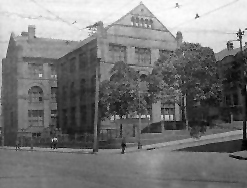
Sydney Technical College at Maryanne Street, Ultimo in 1950, which history dates back to 1843
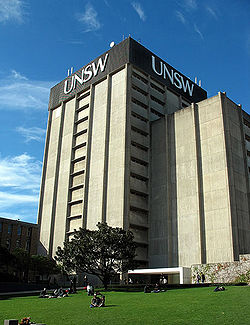
University Library Building
The idea of founding the University originated from the crisis demands of World War II, during which the nation's attention was drawn to the critical role that science and technology played in transforming an agricultural society into a modern and industrial one. The post-war Labor government of New South Wales recognised the increasing need to have a university specialised in training high quality engineers and technology-related professionals in numbers beyond that of the capacity and characteristics of the existing University of Sydney. This led to the proposal to establish the Institute of Technology, submitted by the then New South Wales Minister for Education Bob Heffron, accepted on 9 July 1946. Instead of creating a completely new Institute, the government decided to have the existing Sydney Technical College operating at Ultimo substantially expanded.
The University, originally named the "New South Wales University of Technology", gained its statutory status through the enactment of New South Wales University of Technology Act 1949 (NSW) by Parliament of New South Wales in Sydney in 1949. In March 1948 classes commenced operation with its first cohort of 46 students pursuing programs including Civil Engineering, Mechanical Engineering, Mining Engineering and Electronic Engineering. At that time the thesis programmes were innovative, in the sense that each course embodied a specified and substantial period of practical training in the relevant industry. It was also unprecedented for tertiary institutions at that time to include compulsory instruction in humanities.
Initially the University operated from the inner Sydney city campus at Ultimo (the current site of the University of Technology, Sydney). However, in 1951, the Parliament of New South Wales passed the New South Wales University of Technology (Construction) Act 1951 (NSW) to provide funding and allow buildings to be erected at the Kensington site where the university is now located.
In 1958 the University name was changed to the 'University of New South Wales' to reflect its intention to transform itself from a technology-based university to an all-rounded generalist university. In 1960 it broadened its curriculum and student base with the establishment of a Faculty of Arts and a Faculty of Medicine, soon to be followed by the Faculty of Law in 1971
The university's first director was Arthur Denning (1949–1952), who made important contributions to the foundations of the university. In 1953 he was replaced by Professor Philip Baxter, who continued on as vice-chancellor when this position's title was changed in 1955. Baxter's dynamic authoritarian management was central to the University's first twenty years. His visionary - but at times controversial - energies saw the university grow from a handful to 15,000 students by 1968 [5]. He also pioneered new scientific and technological disciplines against an external background of traditionalist criticism. Growing staff levels, recruited both locally and overseas, conducted research which soon established a wide international reputation. By the time of Sir Philip Baxter's retirement in 1969 the University had made a unique and enterprising mark on Australia. The new Vice-Chancellor, Professor Rupert Myers (1969–1981), brought consolidation and an urbane management style to a period of expanding student numbers, demand for change in University style, and challenges of student unrest.
The stabilising techniques of the 1980s managed by Vice-Chancellor Professor Michael Birt (1981–1992) provided a firm base for the energetic corporatism and campus enhancements pursued by the subsequent Vice-Chancellor, Professor John Niland (1992–2002). The 1990s saw the addition of a Fine Arts dimension to the University and further development of the public and community outreach which has characterised the University from its beginnings. At present, private sources contribute 45% of its annual funding [6].
The University established Colleges in Newcastle (1951) and Wollongong (1961), which eventually became two independent universities in 1965 and 1975 respectively, namely the University of Newcastle and the University of Wollongong.
In May 2007, the University announced its termination of all programs offered at its Asian campus in Singapore after only one semester, due to lower than expected student numbers and a reappraisal of its financial viability by the new Vice-Chancellor.
The University is home to the Lowy Cancer Research Centre. The new centre, costing $100 million, is Australia's first facility to research and perform clinical drugs trials into both adult and children's cancers under one roof.
Governance
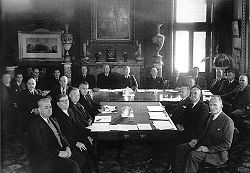
University council's first meeting in 1949
The University is governed by a Council of 22 members including parliamentary and ex-officio members, members elected by staff, students and graduates of the University, and members appointed by the Minister for Education or by Council itself. It is responsible for acting on the University’s behalf to promote its objectives and interests. The governance of universities has come under increasing scrutiny nationally in recent years, and UNSW and its Council are committed to meeting this scrutiny by demonstrating the highest standards.
The principal academic body is the Academic Board which receives advice on academic matters from the Faculties, College (Australian Defence Force Academy), and the Boards of Studies. It is responsible for academic policy setting, academic strategy via its eight standing committees, approval and delivery of programs, and academic standards. The Board comprises 56 members, including the Chancellor and Deputy-Chancellor, members of the SMG, Deans and Faculty Presiding Members, 24 members elected from the academic staff and four from the student body. Membership also includes ‘such other persons’ approved by Council. The Academic Board advises the Vice-Chancellor and Council on matters relating to teaching, scholarship and research and takes decisions on delegation from Council. Its purpose is to make academic policy; approve courses and programs; further and co-ordinate the work of the Faculties and other academic units; and support teaching, scholarship and research.
The Faculties and boards are responsible for the teaching and examining of subjects within their scope and the Academic Board co-ordinates and furthers their work.
The chief executive officer of the University is the Vice-Chancellor and President. The Deputy Vice-Chancellors and Pro-Vice-Chancellors are responsible for academic operations, research policy, research management, quality assurance and external relations including sponsorship.
In June 2004, then Vice-Chancellor Rory Hume resigned as a result of the Bruce Hall controversy, a series of events in which former Professor Bruce Hall was found guilty of academic misconduct in medical research. As a result of his handling of the affair, which drew criticism from the media and within the university, Professor Hume was pressured by the Chancellor and others to resign. Professor Hume officially resigned on 30 June 2004 after a breakdown in his working relationship with the University's governing council. Professor Mark Wainwright was appointed Vice-Chancellor in July 2004, having been Acting Vice-Chancellor following Professor Hume's resignation.
Ranking and performance
In 2000, UNSW was ranked by AsiaWeek as 10th in the Asia-Pacific region and 3rd among Australian universities by Asiaweek [7]. The ranking has since been discontinued.
In 2008, UNSW received the maximum five-star rating for nine key performance indicators, well above any other Group Eight University, in the 2008 Good Universities Guide. In total points across all categories, UNSW was the national leader, outrating all other universities. It achieved a top score for student demand, graduate starting salaries, research grants, research intensivity, student–staff ratios, cultural diversity, gender balance, and international enrolments. The University was ranked 47th on the 2009 Times Higher Education Supplement World University Rankings, ranking fifth among Australian universities.
In 2008, an analysis from Thomson Scientific, global research and development analysts, showed that UNSW is one of the top three institutions in Australia for leading in particular fields, dominating in mathematics, psychiatry and psychology. In these areas, the top three Australian institutions were the University of Sydney, UNSW and the University of Melbourne, respectively.
In 2008, UNSW received the highest level of funding in Linkage Grants from the Australian Research Council of any university in the country, including four grants worth more than $1 million. The largest grant went to a team lead by Professor Martin Green to develop a new generation of low-cost silicon solar cells.
In 2009, the Financial Times Global MBA ranking placed The Australian School of Business 32nd worldwide, and top in Australia, with an average alumni salary of US$127,474. In the 2007 survey, the school's Executive MBA program was ranked 23rd worldwide. It is also the only Australian business school featured in the rankings for 7 consecutive years.
Students and organizations
UNSW currently has approximately 40,000 students studying in 600 undergraduate and postgraduate academic programs. Over 5,000 full-time staff work in its 76 schools, 69 research centres, 6 institutes, 4 teaching hospitals, 8 residential colleges and many administrative departments.
It was reported in the 1990s that more than half of New South Wales' top HSC students consistently make UNSW their first preference. In 2000, 17 of the 22 students who achieved a perfect 100 on the University Admissions Index (UAI) decided to commence studies at UNSW. In the same year, the NSW Board of Studies and the Universities Admissions Centre said that the University attracted 55 per cent of the top 1 per cent of performers.
In 2007, the four previous student organisations, the UNSW Student Guild, Postgraduate Board, UNSW Union and COFA Students' Association were wound up and reformed as a new student organisation known as the Arc @ UNSW. This new student organisation is a major service provider on campus, running a number of retail outlets, student media such as Tharunka and the entertainment venue, the Roundhouse. The Arc Student Representative Council represents students to the university and nationally and fights for their rights. Arc also provides support and funding to university clubs and societies and runs student volunteer programs such as Orientation Week.
In 2008 the University of New South Wales Sports Association and UNSW Lifestyle Centre merged to become UNSW Sport and Recreation. It runs the UNSW Fitness and Aquatic Centre, provides health and fitness facilities and services, and supports the thirty UNSW affiliated sporting clubs that compete both at home and abroad.
Faculties
The University has nine faculties:
- Arts and Social Sciences
- Australian Defence Force Academy
- The Australian School of Business
- Built Environment
- College of Fine Arts
- Engineering
- Law
- Medicine
- Science
校园
See also: Venues at the University of New South Wales
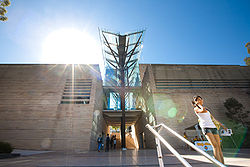
The John Niland Scientia Building
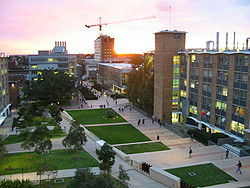
Lower campus in the sunset
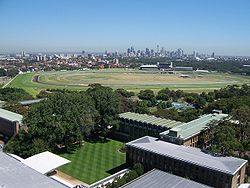
Looking from UNSW across Randwick Racecourse to Sydney city
The main UNSW campus is situated in Kensington, Sydney. Two of the University's faculties are situated elsewhere. The College of Fine Arts, is located in the inner suburb of Paddington. The Australian Defence Force Academy is situated in Canberra. The University also has additional campuses and field stations at Randwick, Coogee, Botany, Little Bay, Dee Why, Cowan, Manly Vale and Fowlers Gap.
The main UNSW campus is divided geographically into two areas: upper campus and lower campus. These two are separated mainly by an elevation rise between the quadrangle and the Scientia building. It takes roughly fifteen minutes to walk from one extreme to the other.
The University has recently set up a high-grade Analytical Centre, which will co-locate major research activities for the Faculties of Science, Medicine and Engineering. It will be used to study the structure and composition of biological, chemical and physical materials.
The University has a number of residential colleges, including: Philip Baxter College, Basser College, Goldstein College, New College, Warrane College, International House, Shalom College and Creston College.
|
|
Main walkway on lower campus
|
|
Library Lawn on upper campus
|
|
|
|
|
Chemical Sciences building
|
The Australian School of Business
|
University Mall during O-Week
|
Academic competitions
UNSW is well known for its engagement with primary and secondary education, administering several national and international academic competitions for school age children. These include, among others, the Australian Schools Science Competition, the Australasian Schools Mathematics Assessment and the UNSW ProgComp (Programming Competition). Many thousands of students in the Australasian area, the Pacific and South Africa participate each year.
UNSW, through the Gifted Education Research Resource and Information Centre (GERRIC), and Grant and Research centre for Education and Scholarly Success (GRESS), also administers the Australian Primary Talent Search (APTS) and Australian Secondary Schools Educational Talent Search (ASSETS) tests to explore and assess the abilities of gifted children.
UNSW School of Computer Science and Engineering (UNSW COMPUTING) has developed specialised robotic workshops for school students. They focus on the use of the Lego NXT technology combined with the popular RoboCup Junior competition for schools. UNSW COMPUTING is also a National and NSW State sponsor of RoboCup Junior.
Notable alumni
See list of UNSW alumni
Notes
- ^ UNSW Annual Report 2007 Vol 2 Financial Statements p29 [1], Retrieved on 2007-09-12
- ^ "Facts in Brief - Staff". UNSW Institutional Analysis and Reporting Office. 2007-03-31. http://www.planning.unsw.edu.au/statisticsdocs/briefstaff.html. Retrieved 2008-07-03.
- ^ "Facts in Brief - Enrolments". UNSW Institutional Analysis and Reporting Office. 2007-03-31. http://www.planning.unsw.edu.au/statisticsdocs/briefenrolments.html. Retrieved 2008-07-03.
- ^ About University of New South Wales, University 21, Retrieved on 2006-10-20
- ^ O'Farrell, UNSW, a portrait: the University of New South Wales, 1949-1999, UNSW Press, 1999 at p15 ISBN 0-86840-417-9
- ^ 'University Official Records', University of New South Wales Records & Archives Office, http://www.recordkeeping.unsw.edu.au
- ^ O'Farrell, UNSW, a portrait: the University of New South Wales, 1949-1999, UNSW Press, 1999 at p33 ISBN 0-86840-417-9
- ^ State Archives, UNSW Records and Archives Office.
- ^ University of New South Wales - UNSW Home - The Vice-Chancellors of the University of New South Wales Exhibition
- ^ University of New South Wales - UNSW Home - The Vice-Chancellors of the University of New South Wales Exhibition
- ^ UNSW: The University of New South Wales - Search, Retrieved on 2007-05-23
- ^ "New cancer research centre for Sydney", Sydney Morning Herald. Retrieved on 2007-09-23.
- ^ Swan, Norman (2 February 2004). "Follow up on Bruce Hall Affair". Australian Broadcasting Corporation - ABC Radio National. http://www.abc.net.au/rn/talks/8.30/helthrpt/stories/s1036825.htm.
- ^ University of New South Wales (23 December 2003). "Decision announced in Hall matter". Press release. http://www.unsw.edu.au/news/pad/articles/2003/dec/Hall_release.html. Retrieved 2007-11-27.
- ^ Doherty, Linda; Matthew Thompson (10 April 2004). "On his uni highway, Hume became roadkill". The Sydney Morning Herald. http://www.smh.com.au/articles/2004/04/09/1081326929792.html?from=storyrhs. Retrieved 2007-11-27.
- ^ Swan, Norman (2 February 2004). "Controversy over Prof. Hall's scientific research continues". Australian Broadcasting Corporation. http://www.abc.net.au/am/content/2004/s1036152.htm.
- ^ Donald, Peta (8 April 2004). "University of NSW Vice Chancellor to resign". Austrlaian Broadcasting Corporation. http://www.abc.net.au/am/content/2004/s1083750.htm.
- ^ University of New South Wales (8 April 2004). "Statement from the Chancellor". Press release. http://www.unsw.edu.au/news/pad/articles/2004/apr/Chancellor_statementMNE.html. Retrieved 2007-11-27.
- ^ 2008 Good Universities Guide [2] Retrieved on 2008-11-06
- ^ "THES World University Rankings - The University of New South Wales". Times Higher Education. http://www.topuniversities.com/university/448/the-university-of-new-south-wales. Retrieved 2010-05-10.
- ^ Thomson Scientific UNSW Ranks in Top Three in Australia [3] Retrieved on 2008-11-06
- ^ "UNSW scoops the pool in Linkage Grants". UNSW Media & Communications. 2008-05-28. http://www.unsw.edu.au/news/pad/articles/2008/may/Linkage_grants.html. Retrieved 2008-07-03.
- ^ "Global MBA Rankings". Financial Times. http://rankings.ft.com/global-mba-rankings/australian-graduate-school-of-management. Retrieved 2009-01-29.
- ^ Executive MBA ranking 2006 Table, Financial Times (UK)[4] Retrieved on 2006-10-27
- ^ Luis M, Why Top Students Prefer UNSW, Sydney Morning Herald, 16 July 1996
- ^ Top University, Sunday Telegraph, 6 February 2000, 25
更多
 |
Australia portal |
 |
University portal |
- List of University of New South Wales people
- National Institute of Dramatic Art
- NICTA - national information and communication technology research centre, co-founded by UNSW
- Venues at the University of New South Wales
参考文献
- Willis, A.H. (1983). The University of New South Wales: The Baxter Years. ISBN 0-86840-057-2.
External links
- Official website University of New South Wales
- UNSW Australian Graduate School of Management
- Campus map
- Google Maps satellite image of the Kensington Campus



